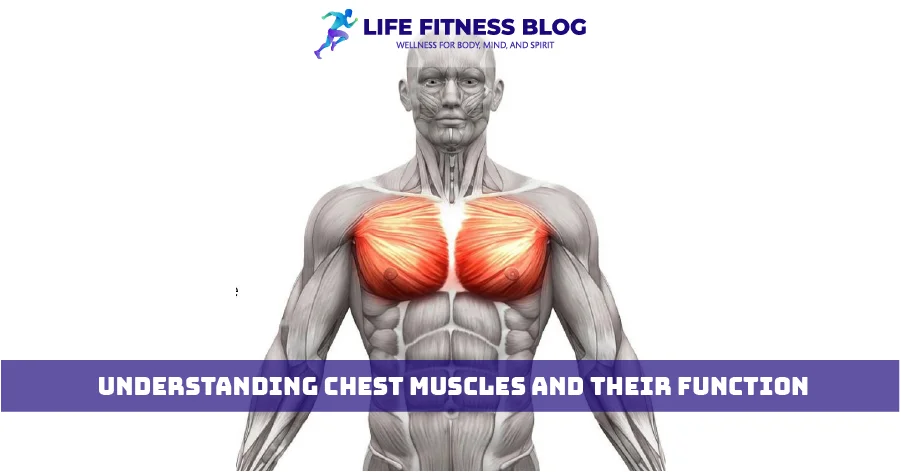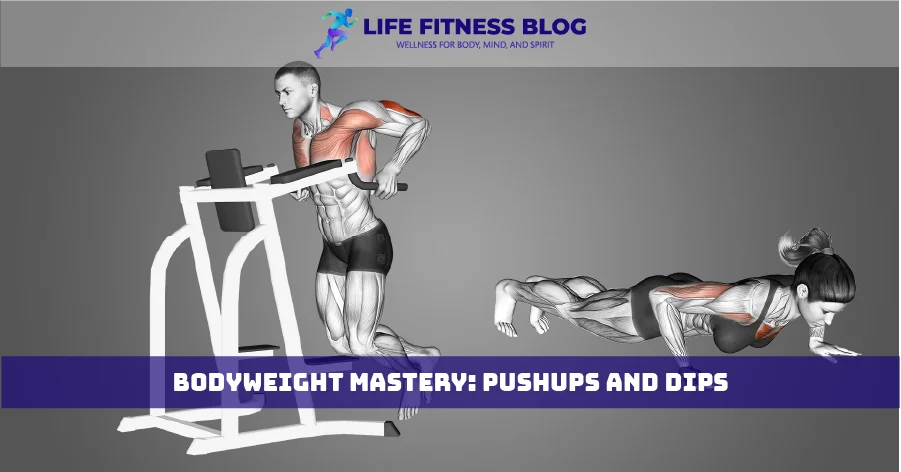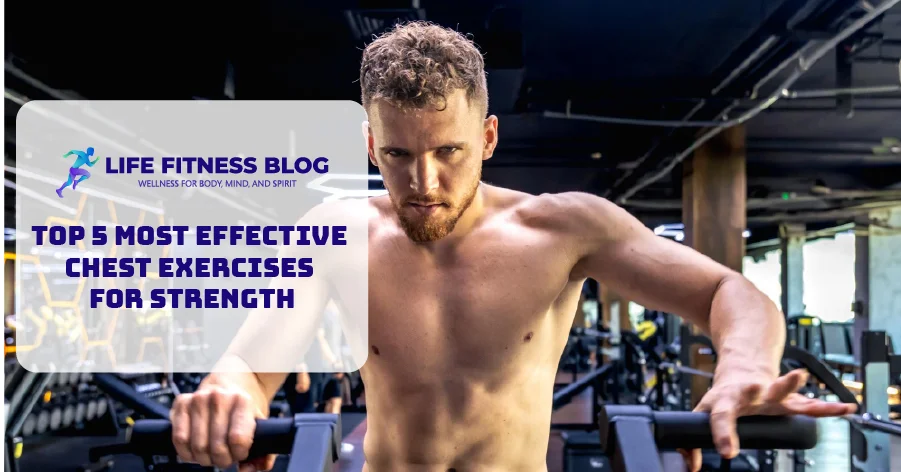Unlocking your upper body strength starts with the right exercises. This guide will show you the top 5 chest exercises for a strong, defined chest. These exercises are perfect for both seasoned weightlifters and beginners.
They will help you build a chiseled chest and increase your upper body strength. Get ready to enhance your chest workout routine and see significant muscle growth and strength gains.
Table of Contents
Understanding Chest Muscles and Their Function
To get the most out of your chest muscles, knowing their anatomy and role is key. The pectoralis major and minor are at the core, working together for great chest growth.
Anatomy of the Pectoralis Major and Minor
The pectoralis major is the bigger muscle, covering the upper chest and shoulder. It’s key for the “pec” look and for exercises like bench presses and push-ups. The pectoralis minor, under the major, helps keep the shoulder blade stable and aids in arm movement.
Role of Supporting Muscles in Chest Development
While the major and minor muscles are the main players, others help too. The serratus anterior helps move the shoulder blade, and the intercostal muscles keep the rib cage stable during presses. Using these muscles can boost chest strength and look.
Benefits of Strong Chest Muscles
- Improved upper body strength and power for everyday activities and athletic performance
- Enhanced overall upper body aesthetics and muscular balance
- Better shoulder stability and reduced risk of injury
- Increased core stability and trunk strength
Knowing how chest muscles work lets you train them better. This unlocks their full power, leading to a strong, toned upper body.
Essential Equipment for Chest Training
To improve your chest training, you need the right tools. From weight benches to resistance bands, the right equipment makes a big difference. It helps you target and strengthen your pectoralis muscles effectively. Let’s look at the key chest training equipment for a powerful, well-defined chest.
Weight Benches: The Cornerstone of Chest Workouts
A good weight bench is key for many chest exercises. It’s essential for the bench press and incline and decline presses. Choose a sturdy, adjustable bench that fits your weight and keeps you stable.
This versatile piece lets you work your chest from different angles. It boosts muscle growth and definition.

Dumbbells: Unleashing Unilateral Chest Strength
Dumbbells add a new level of muscle activation and strength to your chest routine. Try dumbbell presses and flyes to build a balanced chest. Use different weights to challenge your muscles and promote growth.
Barbells: The Time-Honored Choice for Chest Gains
The barbell bench press is a classic for chest training. It lets you lift heavy weights and work multiple muscles at once. Invest in a strong barbell and plates for better chest development.
Focus on safety and control with heavy loads. Proper form is key.
Resistance Bands: Versatile Chest Sculpting Tools
Resistance bands are a unique and challenging way to train your chest. They’re portable and lightweight, great for chest exercises like banded push-ups and resistance band flyes. Adding them to your routine boosts tension and endurance, enhancing your chest workouts.
Using these essential chest training tools will help you build a strong, sculpted chest. Always focus on proper form and increase intensity slowly for safe, effective progress.
Top 5 Most Effective Chest Exercises for Strength
Many people want a strong, well-defined chest. To help you achieve this, we’ll look at the top 5 chest exercises. These should be part of your workout plan.
Proper Form and Technique Guidelines
Getting the most out of these exercises means using the right form and technique. Make sure your body is in the right position and you’re using the right muscles.
Common Mistakes to Avoid
Knowing common mistakes is key to avoiding them. This way, you can adjust your form and do the exercises correctly.
Progressive Overload Principles
Progressive overload is crucial for muscle growth. It means increasing the weight or intensity of your workouts. This pushes your muscles to get stronger.
Now, let’s look at the top 5 chest exercises for strength and muscle:
- Bench Press – This exercise works the chest, shoulders, and triceps. Keep your feet on the ground and your back slightly arched.
- Pushups – Pushups are great for the chest. Try different hand positions to target different parts of your chest.
- Dumbbell Flys – These exercises focus on the chest. Keep your elbows still and control the movement.
- Cable Crossovers – Cable crossovers work the chest in a special way. Keep your posture right and move smoothly.
- Dips – Dips work the chest, shoulders, and triceps. Make sure to control your descent and keep your core tight.
Consistency and focus are important when doing these exercises. Mastering the right techniques and using progressive overload will help you build a strong chest.

Mastering the Bench Press for Maximum Results
The bench press is a key chest exercise that shows strength and muscle growth. Learning the right bench press technique is key for a strong, muscular chest. It helps you reach your fitness goals.
This exercise works many muscles, like the chest and triceps. By focusing on proper form and adding more weight, you can get the most out of it.
Proper Bench Press Technique
- Grip the bar with your hands slightly wider than shoulder-width apart, keeping your wrists in a neutral position.
- Retract your shoulder blades, creating a stable and arched back position on the bench.
- Plant your feet firmly on the floor, engaging your core and leg muscles to stabilize your body.
- Lower the bar in a controlled motion, keeping your elbows at a 45-degree angle from your body.
- Press the bar back up, fully extending your arms without locking out your elbows.
Common Mistakes to Avoid
- Flared Elbows: Keeping your elbows too wide can put unnecessary stress on your shoulder joints and limit the effectiveness of the exercise.
- Arched Back: An exaggerated arch in your back can compromise your stability and put undue pressure on your spine.
- Bouncing the Bar: Letting the bar bounce off your chest can lead to injury and reduce the overall muscle-building stimulus.
Consistency and proper form are crucial for mastering the bench press. Adding this key chest exercise to your chest workout routine will help you build a strong, muscular chest. It will also improve your bench press technique.
Advanced Techniques with Dumbbell Flys and Cable Crossovers
Take your chest workout to the next level with smart grip changes and motion control. Mastering dumbbell flys and cable crossovers lets you hit different chest muscles. This can lead to new growth in your pectorals.
Grip Variations and Their Impact
Try different grip styles for dumbbell flys and cable crossovers to target various chest muscles. A neutral grip, where palms face each other, works the pectoralis major best. An underhand grip, with palms down, focuses on the pectoralis minor. An overhand grip, with palms up, engages the anterior deltoids more.
Range of Motion Considerations
Make your dumbbell flys and cable crossovers more effective by controlling your motion. Make sure to fully contract your chest muscles at the top. Then, lower the weights slowly until you feel a stretch in your pectorals. Don’t let the weights drop too low to avoid shoulder strain.
Weight Selection Guidelines
| Exercise | Optimal Weight Range | Reps |
|---|---|---|
| Dumbbell Flys | 20-40 lbs per dumbbell | 8-12 |
| Cable Crossovers | 15-30 lbs per side | 10-15 |
These are just starting points. Your ideal weight will vary based on your strength, goals, and how your muscles respond. Adjust the weights to keep proper form and get the most out of each exercise.
Bodyweight Mastery: Pushups and Dips
Building a strong, well-defined chest is easier with bodyweight exercises like pushups and dips. These exercises are simple yet powerful. They are the heart of a chest workout routine that can be done anywhere, anytime, without equipment.
Pushups target the pectoralis major and minor muscles, along with the triceps and anterior deltoids. Changing hand placement can focus on different chest areas. For example, a wide-grip pushup works the outer chest more, while a narrow-grip targets the triceps.
Dips, on the other hand, work the chest, shoulders, and triceps. You use your body weight to lower yourself between two bars or a bench edge. Leaning forward slightly emphasizes the chest, making dips great for your chest workout.
To get better at these exercises, focus on proper form and increase the challenge as you get stronger. Start with basic pushups or bench dips. Then, try incline, decline, or one-arm variations to keep pushing your muscles.
Adding pushups and dips to your chest workout can build impressive strength and muscle. These exercises show the power of bodyweight training. They prove that a well-rounded chest workout can be effective without any equipment.

Creating Your Optimal Chest Training Schedule
Creating a good chest training schedule is key to reaching your fitness goals. It’s important to plan your workouts, rest, and progress well. This helps grow your chest muscles and increase strength. Let’s look at the main things to think about when making your chest training schedule.
Recovery and Rest Periods
Getting enough rest is vital for your chest muscles to grow and repair. Make sure to rest for 48-72 hours after intense chest workouts. This rest lets your body refill energy, fix muscle damage, and adjust to the workout.
Not getting enough rest can cause overtraining, increase injury risk, and slow down chest growth.
Workout Frequency Recommendations
- Train your chest 2-3 times per week for the best results.
- Start with 2 chest workouts a week if you’re new. Increase to 3 as you get more experienced and recover better.
- Experienced lifters might do 3-4 chest workouts a week. Just make sure to control the volume and intensity.
Progressive Program Design
To keep challenging your chest and making progress, add progressive overload to your program. This means slowly increasing the weight, reps, sets, or exercise difficulty. By always changing your program, you’ll keep growing new muscles and getting stronger in your chest.
| Chest Training Schedule Progression | Beginner | Intermediate | Advanced |
|---|---|---|---|
| Workout Frequency | 2 times per week | 3 times per week | 3-4 times per week |
| Rest Periods | 48-72 hours | 48-72 hours | 48-72 hours |
| Progressive Overload | Increase weight, reps, or sets over time | Incorporate more advanced exercises and techniques | Highly individualized program with constant adaptation |
By following these tips and customizing your chest training schedule, workout frequency, and progressive program design, you can make a great chest training plan. This plan will support your recovery and help you keep getting stronger and building muscle.
Nutrition and Supplementation for Chest Development
To get a strong chest, you need more than just workouts. Your diet and supplements are key for muscle growth and recovery. Make sure you eat enough to support your chest-building goals.
Eating right means getting enough calories and focusing on protein. Aim for 1.6 to 2.2 grams of protein per kilogram of body weight. Include lean meats, fish, and plant-based foods like beans and lentils. Also, add complex carbs and healthy fats to fuel your body.
Some supplements can help too. Whey protein, creatine, and beta-alanine are good for muscle and strength. Always talk to a healthcare expert before adding supplements to your routine.
Also Read:
FAQs
How often should I train my chest muscles?
Training your chest 2-3 times per week is a good starting point. However, the optimal frequency depends on your fitness level, recovery ability, and overall training volume. Listen to your body and adjust your training schedule accordingly.
What are some common mistakes to avoid when doing chest exercises?
Common mistakes include using poor form, not engaging the core, and not fully extending the arms at the top of the movement. To avoid these mistakes, focus on proper technique and seek guidance from a qualified trainer if needed.
How can I increase the intensity of my chest workouts?
To increase intensity, you can gradually increase the weight or resistance, increase the number of repetitions, or decrease rest periods between sets. You can also try different variations of exercises to challenge your muscles in new ways.
What is the importance of rest and recovery in chest training?
Rest and recovery are crucial for muscle growth and repair. Ensure you get enough sleep, eat a balanced diet, and listen to your body’s signals. Overtraining can lead to injuries and hinder progress.
Can I build a strong chest without weights?
Yes, you can build a strong chest using bodyweight exercises like push-ups and dips. However, to continue progressing, you may eventually need to incorporate additional resistance, such as resistance bands or dumbbells.




